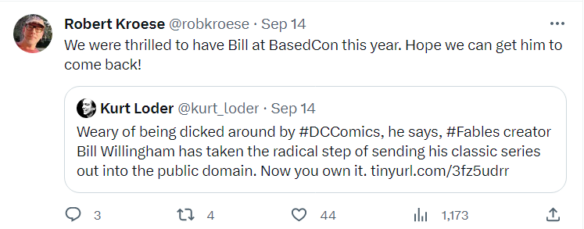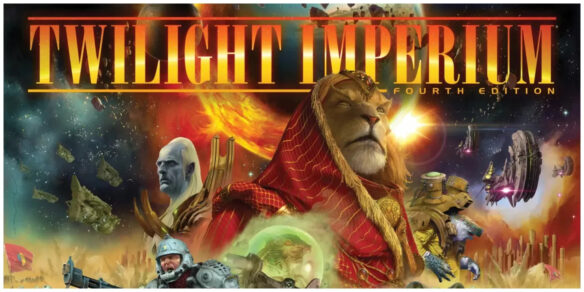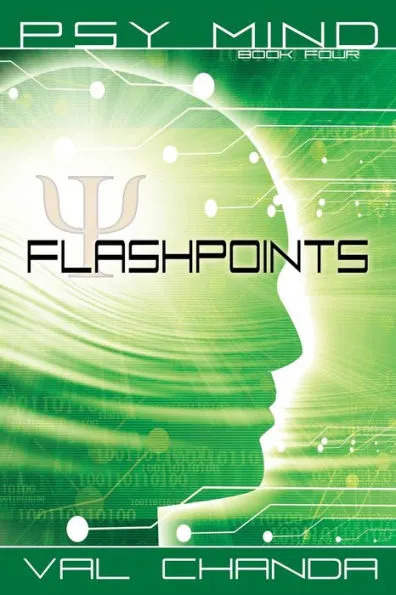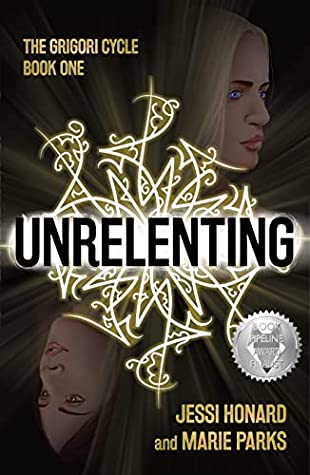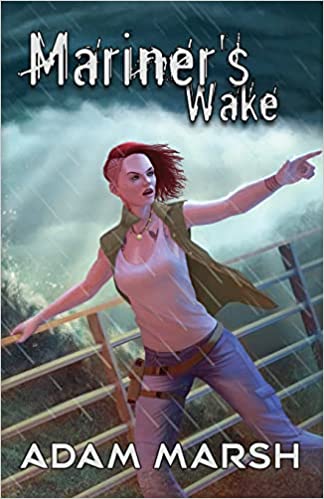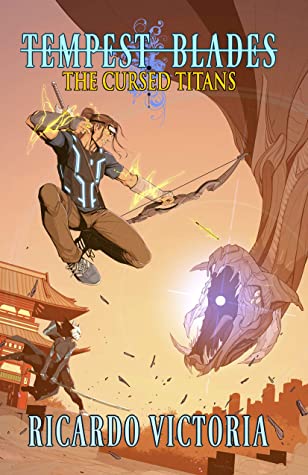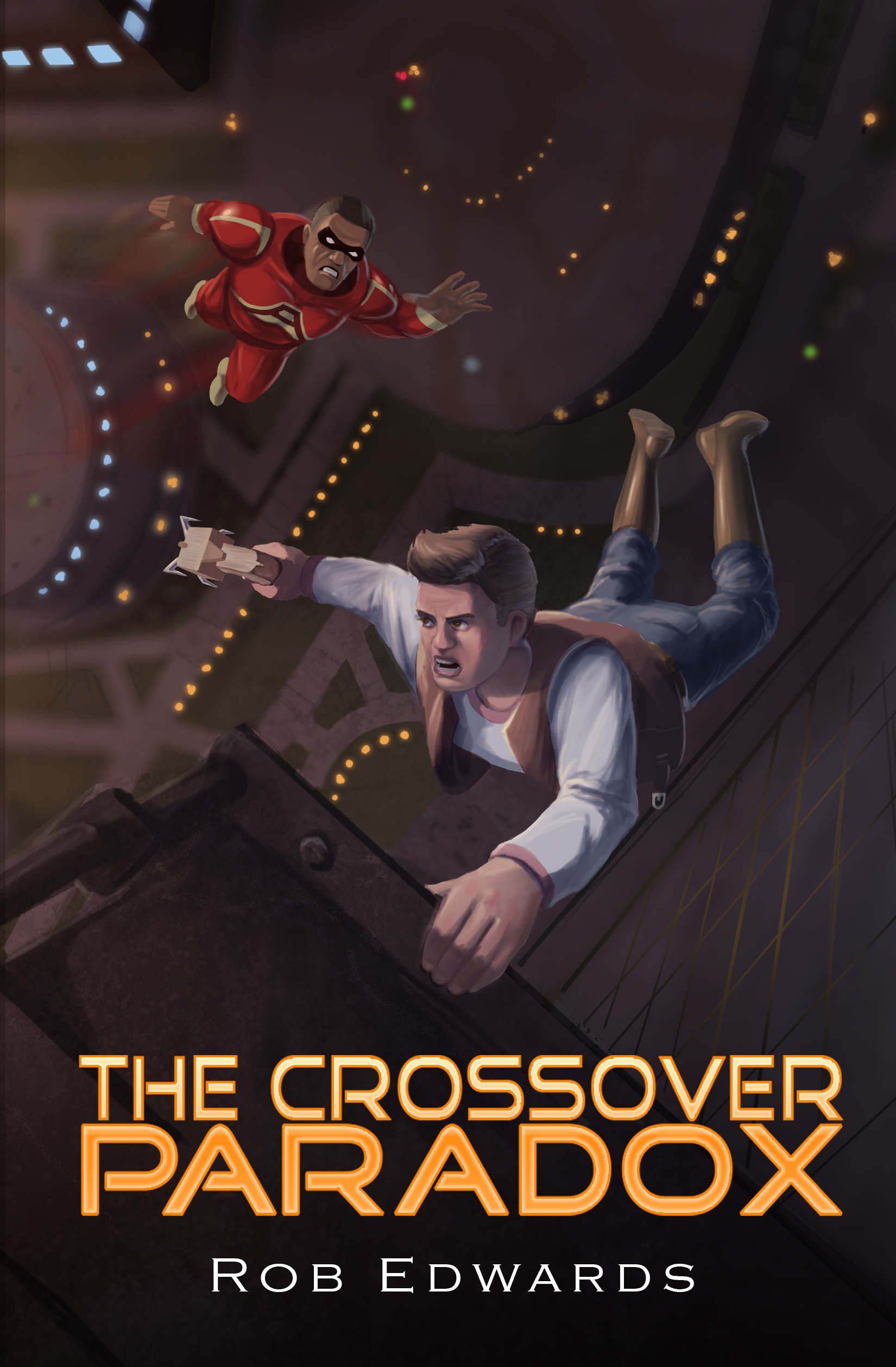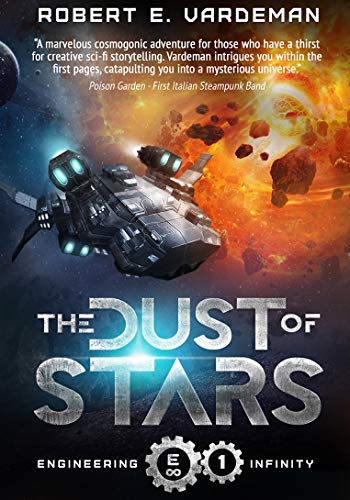(1) WAYS IN WHICH PRATCHETT IS STILL WITH US. Sam Jordison discusses “Pratchett power: from lost stories to new adaptations, how the late Discworld author lives on” in the Guardian.
“Of all the dead authors in the world, Terry Pratchett is the most alive,” said John Lloyd at the author’s memorial in 2015. This sentiment remains as true now, 40 years after the publication of Pratchett’s first Discworld novel, The Colour of Magic. The anniversary has been commemorated in a set of illustrated Royal Mail stamps. There’s been a show dedicated to Pratchett at the Edinburgh fringe. A Kickstarter for a graphic novel adaptation of Good Omens, the book he co-wrote with Neil Gaiman, became the number one comics campaign in Kickstarter history, bringing in more than £2.4m; a second series of the TV adaptation was also released.
All this would make 2023 an impressive year by any writer’s standards – but happened in the month of August alone. The big event comes this month, with the publication of A Stroke of the Pen, a collection of rediscovered early stories. This past year also brought an animated adaptation of Pratchett’s children’s novel The Amazing Maurice, and a new set of Discworld audiobooks….
Naturally, the best paragraphs are the ones that quote Pratchett:
…Not that Pratchett was universally disparaged: the critics who actually read his books tended to like them. When AS Byatt reviewed Thief of Time, she said it deserved to win the Booker prize. Of course, Pratchett never got a look in. “Thank goodness,” he said, “because I think my earnings would have gone down considerably if I suddenly got literary credibility.” He also joked that when he was given an OBE for services to literature, those services “consisted of refraining from trying to write any”…
(2) BEARS DISCOVER TYPING. Margaret Grebowicz traces “Terry Bisson’s History of the Future” in The New Yorker.
… In 1969, Bisson quit writing for a decade and left New York for “hippie commune” work in the South and Southwest. He met his wife, Judy Jensen, in a commune, and they became involved in the May 19th Communist Organization, a group created by former members of the Weather Underground. In 1975, the couple moved back to New York to organize for May 19th, and Bisson worked as an auto mechanic in taxi garages and a copywriter. He sold his first science-fiction novel, “Wylrdmaker,” to the publisher David Hartwell in 1981, for fifteen hundred dollars. The novel was pulp: it told the story of Kemen of Pastryn, a satirical futuristic version of Conan the Barbarian. It wasn’t the book Bisson wanted to write, he told me, but “it was the smartest thing I ever did. That’s when I discovered you didn’t have to be fucking Hemingway or Fitzgerald to write a novel.” His second novel, “The Talking Man,” was more of a passion project—it was a fantasy novel set in the rural South, with junkyards instead of castles. “There was a sense of science fiction as a very urban literature and the future as a very urban place,” the writer Karen Joy Fowler told me. “Terry’s perspective was more land-based, regional, and populist.”
If May 19th had asked him to do anything risky, Bisson would have. But he was always suspected of being a “petit-bourgeois intellectual” and thus was kept on the sidelines. In 1985, he was subpoenaed to testify in front of a grand jury, to identify friends who had gone into hiding, and who were suspected for bombings at the Capitol and three military bases nearby. He refused to comply, and spent three months in prison—a short stint, he notes, compared with those of his friends. There, Bisson started his third novel, “Fire on The Mountain,” an alternative history in which the abolitionist John Brown’s revolt at Harper’s Ferry succeeded. When it was published, in 1988, Bisson dedicated the book to Kuwasi Balagoon and the Black Liberation Army….
(3) THE 1440 MINUTE HATE. Sandra Newman, author of 1984 turnabout Julia, tells “What I learned about today’s rage culture from rewriting 1984” in the Guardian.
…Nowadays, the language of Nineteen Eighty-Four is used by rightwingers to indict “wokeism”. Any new coinage from the left is called “Newspeak”; any attempt to acknowledge moral ambiguity is dismissed as “doublethink”. With the single word “Orwellian”, a college’s overreaching speech policy, for example, is framed as an existential threat to the free world. But Nineteen Eighty-Four wasn’t a warning against a university’s inclusivity statement. It was a warning about men like Trump and Putin and the violent mass movements they inspire….
… When my Nineteen Eighty-Four book was announced, described as a “feminist retelling”, I was treated to a personal experience of how far things had gone. The news attracted a storm of misogynist and antisemitic abuse in rightwing tweets, blogs, YouTube videos, even newspaper articles. This was long before the novel was available to be read – before I’d barely written a few chapters. Still, all the attackers were sure what would be in it: a full-throated endorsement of Big Brother. …
(4) OHAYOCON MELTDOWN. Nerd & Tie is following the controvery between the owner and volunteers of a commercial sff con: “Ohayocon Senior Leadership and Volunteers on Strike After Removal of Con Chair Cody Marcum [Updated 10/6]”. A long post at the link.
…From what we’ve been able to gather, it appears that a group of Ohayocon staffers and volunteers had formed an informal union called Convention of Ohio Volunteer Network (COVEN) and presented a document of demands to Phelps and other members of the board of Cultural Exchange Society, Inc on March 4th, 2023. You can read a full version of that document here. …
Update 10/6/2023 (8:50pm CDT): Ohayocon has put out a statement regarding the current situation which is, frankly, confusing. In the statement, Ohayocon says “Contrary to misinformation swirling online, NO volunteers or members of the Senior Leadership Team have been fired from Ohayocon…” which is at odds with Phelp’s repeated, explicit statements that the con chair and marketing head had been fired….
(5) SMALL WONDERS 4. Co-editors Cislyn Smith and Stephen Granade are proud to bring a mix of flash fiction and poetry for the spooky month in Small Wonders Issue 4, now available on virtual newsstands here. Subscriptions are available at the magazine’s store and on Patreon.

The Issue 4 Table of Contents and release dates on the Small Wonders website:
- Cover Art: “Rebuilding” by Carrie Alyson
- “Katya’s Microscope” (fiction) by Monica Joyce Evans (2 Oct)
- “Five Easy Hairstyles for Snake-Haired Girls” (poem) by Jelena Dunato (4 Oct)
- “Granny’s Spider” (fiction) by Wen Wen Yang (6 Oct)
- “On the bare unwelcoming shore” (fiction) by Zohar Jacobs (9 Oct)
- “Drunken Supernova” (poem) by Keira Perkins (11 Oct)
- “Faith That Builds Worlds” (fiction) by Eric A. Clayton (16 Oct)
- “If We Live to Be Giants” (fiction) by Allison Mulder (13 Oct)
- “Sever” (poem) by Lora Gray (18 Oct)
- “Five Functions of Your Bionosaur” (fiction) by Rachael K. Jones (20 Oct)
(6) GOAL: DISRUPTION. “Spotify Gave Subscribers Music and Podcasts. Next: Audiobooks.” – in the New York Times.
Four years ago, Spotify’s business was stagnating. Apple had overtaken it as the top paid music service in the United States, losses were mounting and customer growth was slowing.
Daniel Ek, the company’s chief executive, decided that Spotify needed to transform from a music service into the everything store for audio. The first missing piece was podcasts, a business that has helped boost ad sales.
Now Mr. Ek has set his sights on another rapidly growing medium: audiobooks.
On Tuesday, Spotify said that it would begin offering 15 hours of audiobooks each month as part of its streaming service for premium subscribers in Britain and Australia. This winter, it will expand the offering to subscribers in the United States.
Spotify’s expansion into books has the potential to shake up the retail landscape for audiobooks, a fast-growing segment of publishing that has long been dominated by the Amazon-owned audio retailer Audible.
(7) CHENGDU WORLDCON ROUNDUP. [Item by Ersatz Culture.]
Single day tickets now available
Announcement on Weibo ; Chinese-language announcement on the official site ; Damai.cn sales page . There is no corresponding English-language item on the official site, and I don’t think there were FB or Twitter posts either.
Just over two weeks after attending tickets/memberships for the con were halted without notice, the promised single day tickets have finally gone on sale. Key points:
- Adult (over-25) tickets are 128 yuan per day (around $18 USD)
- “Teenager” (13-25) tickets are 78 yuan per day (around $11 USD)
- For reference, the original 5-day ticket prices were 320 and 200 yuan ($44 and $28 USD) respectively
- Tickets are only available for Thursday 19th through Sunday 22nd, i.e. not the opening day
- Ticket sales will close at the end of Saturday 14th (presumably Beijing-time, but this isn’t explicitly stated)
Translations of some of the reply comments on the Weibo post reflect the above:
- I bought three single-day tickets, which are more expensive than the pass, and I can’t participate in the lottery
- Why is there no 18-day single-day ticket opening ceremony at 8pm。This day is a variety of activities, and by then there will be almost no one during the day。
Chengdu magazine cover feature on the Worldcon and SF generally – https://weibo.com/1615055180/NmLaY6rLI
File 770 contributor Feng Zhang posted photos of the October issue of Chengdu Culture/Tianfu Culture, in which the Worldcon is a cover feature, and in which he is interviewed.
A couple of Xiaohongshu posts about the interior decor
- The Wandering Earth 2 exhibit has progressed a bit since the video included in a Scroll a couple of days ago. http://xhslink.com/KAbNfv (I’ve attached the image, as there’s not much else to that post)
- A company making large lamps seems to be making replicas of the planets to be displayed at the con. http://xhslink.com/739Mfv The text of the post refers to “10 major planets”, so maybe Pluto-diehards will be in luck?
(8) CAN’T SLIP ONE BY HIM. A scholar suspects the language of Watership Down is spreading to English. “Lapine Lingo in American English: Silflay”.
Lapine Lingo in American English: Silflay; Author(s): Thomas E. Murray; Source: American Speech , Winter, 1985, Vol. 60, No. 4 (Winter, 1985), pp. 372-375; Published by: Duke University Press
“The general conclusion concerning silflay and its infiltration into American speech, then, is clear: whereas the Russians may or may not be coming, the rabbits have definitely already come and gone, and in their short stay have left a significant linguistic imprint on a sizable portion of the American population. As for the future of silflay, I think it may warrant further attention. Will its popularity die a slow and inconsequential death, as is the case with so many nonce creations, or will it spread, either geo-graphically or socioeconomically, to other English-speaking peoples? Moreover, what of the other terms that Adams created (over forty are listed in the Glossary at the end of the novel)? Will one or more of them charm some innocent lover of bunnies into increasing his or her vocabulary and thus propagating other aspects of the lapine lingo? Perhaps not, but given the current, unexpected popularity of silflay, the entire rabbit language phenomenon certainly bears watching.”
(9) NM-AZ BOOK AWARD WINNERS. The New Mexico Book Co-op has announced the 2023 winners of the New Mexico-Arizona Book Awards.
The winner in the Sci-Fi category is Avery Christy for Mountain Knight.

(10) TODAY’S BIRTHDAYS.
[Compiled by Cat Eldridge.]
- Born October 7, 1938 — Jane Gallion (Ellern). Writer, Poet, and Fan who was one of the members of the Los Angeles Science Fiction Society subgroup The Blackguards, which hosted many parties and tournaments. She edited the fanzines Karuna, and Topaze (etc.), contributed to many other fanzines over the years, and was known for her three post-apocalyptic novels which were very early examples of feminist works involving explicit sex. (Died 2003.)
- Born October 7, 1942 — Lee Gold, 81. She’s a member of LAFA and a writer and editor in the role-playing game and filk music communities. She published Xenofilkia, a bi-monthly compilation of filk songs which has been published since 1988, four issues of the Filker Up anthology; and has published for forty-four years, Alarums and Excursions, a monthly gaming zine. She’s edited more fanzines than I care to list here, and is a member of the Filk Hall of Fame along with Barry Gold, her husband.
- Born October 7, 1945 — Hal Colebatch. Lawyer, Journalist, Editor, and Writer from Australia who has written, singly or in collaboration, two novels and at least two dozen shorter pieces set in Larry Niven’s The Man-Kzin Wars series. However, his main body of work is non-genre, including six books of poetry, short stories, and radio dramas and adaptations. His non-fiction books include social commentary, biography and history, and he has published many hundreds of articles and reviews in various news and critical venues. (Died 2019.)
- Born October 7, 1946 — Chris Foss, 79. UK Illustrator known for the Seventies UK paperback covers for Asimov’s Foundation trilogy and E. E. “Doc” Smith’s Lensman and Skylark series among many that he did. He also did design work for the Jodorowsky version of Dune. Alien has his Spaceship design, and he did redesign of Gordon’s rocket cycle for the 1980 Flash Gordon film.
- Born October 7, 1947 — John Brosnan. Australian writer who died way too young of acute pancreatitis. He used at least seven pseudonyms, and wrote scripts for a number of what I’ll generously call horror films including one I know that somehow I saw — Carnosaur. If you like your SF with a larger dose of pulp, his Sky Lords trilogy (The Sky Lords, The War of the Sky Lords and The Fall of the Sky Lords) is damn good. Airships, airships! (Died 2005.)
- Born October 7, 1950 — Howard Chaykin, 73. Comic book artist and writer. His first major work was for DC Comics, drawing “The Price of Pain” which was an adaptation of author Fritz Leiber’s characters Fafhrd and the Gray Mouser in Sword of Sorcery #1. He would illustrate damn near everything else from Batman and The Legion of Super-Heroes for DC to Hulk and Iron-Man for Marvel (to name but two series) but I think his best genre work was his own American Flagg! series.
- Born October 7, 1956 — Rick Foss, 67. Historian, Writer, Food Connoisseur, Conrunner, and Fan who has had around a dozen short fiction works published, mostly in Analog, some of which are in his Probability Zero universe. He is also a food writer, maintains a blog of interesting and little-known stories about food and cooking, has published the book Food in the Air and Space: The Surprising History of Food and Drink in the Skies about the history of airline food, and has had occasional food-related contributions on File 770. He is a member of LASFS and SCIFI, has worked many Loscons and other conventions, and chaired Loscon Sixteen in 1990. Along with his twin brother Wolf Foss, he was Fan Guest of Honor and Toastmaster at Windycon 19 in 1992.
- Born October 7, 1959 — Steven Erikson, 64. He’s definitely most known for his Malazan Book of the Fallen series, which began with the publication of Gardens of the Moon and was completed with the publication of The Crippled God, ten novels later. Though I’ve not read it, and didn’t know it existed until now, he’s written the Willful Child trilogy, a spoof on Star Trek and other tropes common in the genre.
(11) COMICS SECTION.
- Candorville livestreams a generation clash.
- Candorville finds a reason to be grumpy about the Updated Drake Equation.
(12) FOR ALL MANKIND MISSION ART. Collectspace.com covers an interesting item: “New collectible pin buttons depict ‘For All Mankind’ space mission patches”. (The direct link to the Icon Heroes product page is here.)
As recently announced by Apple TV+, the fourth season of “For All Mankind” is set to debut on Nov. 10. Created by Ronald D. Moore, along with current showrunners Ben Nedivi and Matt Wolpert, “For All Mankind” explores how humanity’s space exploration efforts may have proceeded differently if the Soviet Union had beaten the United States to landing a man on the moon.
One of the ways the show has distinguished its timeline from our own has been the inclusion of altered or entirely new mission patches worn by the astronauts in the series. For the past three seasons, Icon Heroes, a pop culture collectibles company, has sold limited edition replicas of the “For All Mankind” embroidered emblems.
Now, the Irvine, California-based company is offering those same alternate Apollo artworks, space shuttle symbols and Martian marks as collectible pinback buttons….

(13) 2023 LAUREATE AWARD. The National Fantasy Fan Federation has announced the 2023 Laureate Award winners. The Laureate Award was first given in 1941.
Best Fan Writer — Martin Lock
Best Fan Artist — Jose Sanchez
Best Fan Website — Fanac.org from Joe Siclari, Edie Stern, and Mark Olsen
Best Non-N3F Fanzine — Simultaneous Times Newsletter from Jean-Paul L. Garnier
Best N3F Fanzine — Tightbeam
Best Podcast — Simultaneous Times
Best Novel — Lords of Uncreation by Adrian Tchaikovsky
Best Shorter Work or Anthology — Return to Glory by Jack McDevitt
Best Pro Artist — Austin Arthur Hart
Best Editor — Toni Weisskopf
Best SF Poet — Michael Butterworth
Best Comic Book — New Think 1.0
Best Anime — Chainsaw Man
Best Manga — Mindset
Best Television Show, Film, or Video — Heath Row’s Productions
Best None of the Above — Manuscript Press (Rick Norwood) and aruffo.com for reprinting the daily comic strip Alley Oop
(14) RALPH CRAM’S OEURVE. “The University Architect Who Also Wrote About Haunted Buildings” in the Princeton Alumni Weekly.
The architect who created the look of Princeton’s campus wrote ghost stories. Fittingly, Ralph Adams Cram’s stories are about haunted buildings, and what haunts those buildings is the past. In a story collection that he published in 1895, empty houses prove, over and over, to be anything but. In a crumbling castle near Innsbruck, Austria, where a devilish nobleman once set the ballroom on fire while his guests danced inside, two “ghost hunters” get caught up in a danse macabre. In a secluded convent near Palermo, Italy, a visitor follows a beckoning specter to the site where, a century earlier, the nuns bricked up one of their sisters in the convent’s walls, a heartless punishment for a sin of the heart. In an abandoned old manse in the Latin Quarter of Paris, rumored to have once been a favorite haunt of the city’s witches, a gang of young “rake-hell” students spends the night on a dare, with predictably ghastly results.
The thesis is straightforward: We inhabit buildings, and they inhabit us, in a larger sense than we might think. In 1907, a group of archaeologists who planned to do excavations in the ruins of Glastonbury Abbey performed séances to get advice from the former inhabitants on where to dig. Cram wrote a defense of their methods, arguing not that they dialed up literal ghosts but that buildings are a deep well of memory that outlasts their inhabitants. (The archaeologists found what they were looking for, but England is so crowded with historical odds and sods that they find kings under parking lots, so their chances were already good.)…
(15) TAKE TWO. The solar system has no suspenders but it may have two belts. “Puzzling objects found far beyond Neptune hint at second Kuiper belt” in Science.
Beyond Neptune’s orbit lie thousands of small icy objects in the Kuiper belt, with Pluto its most famous resident. But after 50 astronomical units (AU)—50 times the distance between Earth and the Sun—the belt ends suddenly and the number of objects drops to zero. Meanwhile, in other solar systems, similar belts stretch outward across hundreds of AU….
A new discovery is challenging that picture. While using ground-based telescopes to hunt for fresh targets for NASA’s New Horizons spacecraft, now past Pluto on a course out of the Solar System, Fraser and his colleagues have made a tantalizing, though preliminary, discovery: about a dozen objects that lie beyond 60 AU—nearly as far from Pluto as Pluto is from the Sun. The finding, if real, could suggest that the Kuiper belt either extends much farther than once thought or—given the seeming 10-AU gap between these bodies and the known Kuiper belt—that a “second” belt exists…

(16) ROCKY MOUNTAIN HIGH. “NASA rover makes adventurous trip, then snaps stunning Mars picture” at Mashable.
It was a long slog. But NASA‘s Curiosity rover did it.
The space agency’s car-sized robot, which has ventured up Mars’ Mount Sharp for nearly a decade, successfully traversed rocky terrain to arrive at a scientifically-intriguing site made by ancient avalanches of boulders, debris, and water. Today, this place, Gediz Vallis Ridge, exists as a prominent hill blanketed with large rocks.
After making the arduous trek (scientists worked to find a passable route to this area for three years), the Curiosity rover turned around and snapped an expansive image of the Martian landscape beyond, which NASA released on Oct. 5.
[Thanks to Cat Eldridge, SF Concatenation’s Jonathan Cowie, Mike Kennedy, Juli Marr, Andrew (not Werdna), Mark Roth-Whitroth, Steven French, John-Paul L. Garnier, JeffWarner, Andrew Porter, Ersatz Culture, John King Tarpinian, and Chris Barkley for some of these stories. Title credit belongs to File 770 contributing editor of the day Soon Lee.]

